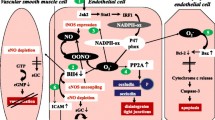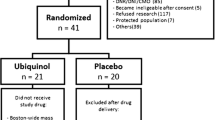Summary
Coenzyme Q10 (CoQ10) is a natural and essential cofactor in the heart. It is the primary redox coupler in the respiratory chain, a potent free radical scavenger, and a superoxide inhibitor. In this study the myocardial protective effects of CoQ10 were determined in high-risk (n = 10) patients during heart surgery compared to that found in placebo controls (n = 10). In both groups, there was a blood CoQ10 deficiency (<0.6 μg/ml), low cardiac index (CI < 2.4 1/m2 per minute), and low left ventricular ejection fraction (LVEF < 35%) before treatment. CoQ10 (100 mg per day) was given orally for 14 days before and 30 days after surgery. Presurgical CoQl0 treatment significantly (P < 0.01) improved blood and myocardial CoQ10 and myocardial ATP compared to that found in the control group. Cardiac functions (CI and LVEF) were improved but not significantly. After cardiac cooling, rewarming, and reperfusion; blood and tissue CoQ10 and tissue ATP levels were maintained in the normal ranges in the CoQ10 patients. Cardiac pumping (CI) and LVEF were significantly (P < 0.01) improved. The recovery course was short (3–5 days) and uncomplicated. In the control group blood and tissue CoQ10, tissue ATP levels, and cardiac functions were depressed after surgery. The recovery course was long (15–30 days) and complicated. Positive relationships between blood and myocardial CoQ10, myocardial ATP, cardiac function, and the postoperative recovery time and course found in both study groups show the therapeutic benefits of CoQ10 in preserving the myocardium during heart surgery. CoQ10 treatment is especially indicated in high-risk cardiac surgery patients who have a natural or clinically induced CoQ10 deficiency.
Similar content being viewed by others
Abbreviations
- ATP:
-
adenosine triphosphate
- C1 :
-
control data collected in the cardiac catheterization laboratory
- C2 :
-
control data collected in the operating room just before cardiac cooling
- CC:
-
cardiac cooling
- CI:
-
cardiac index
- CoQ10 :
-
coenzyme Q10
- CW:
-
cardiac warming
- LVEF:
-
left ventricular ejection fraction
- GI:
-
group I (CoQ10 treatment)
- GII:
-
group II (placebo treatment)
- LVEDVI:
-
left ventricular end-diastolic volume index
- SI:
-
stroke volume index
- SR:
-
surgical recovery
References
Appelbaum A, Kouchoukos NT, Blackstone EH, Kirklin JW (1976) Early risks of open heart surgery for mitral valve disease. Am J Cardiol 37:201–209
Beyer RE, Nordenbrand K, Ernster L (1986) The role of coenzyme Q10, as a mitochondrial antioxidant: a short review. In: Folkers K, Yamamura Y (eds) Biomedical and clinical aspects of coenzyme Q10, vol 5. Elsevier Amsterdam, pp 17–24
Braunwald E, Kloner RA (1982) The stunned myocardium. Prolonged, post-ischemic ventricular dysfunction. Circulation 66:1146–1149
Ernster L (1977) Facts and ideas about the function of coenzyme Q10 in mitochondria. In: Folkers K, Yamamura Y (eds): Biomedical and clinical aspects of coenzyme Q10. Elsevier/North Holland, Amsterdam, pp 15–21
Hess ML, Okobe E, Kontas HA (1982) Proton and free oxygen radical interaction with calcium transport system of cardiac sarcoplasmic reticulum. J Mol Cell Cardiol 13:767–772
Judy WV, Grim CE, Judson WE, Weinburger MH (1981) Comparison of cardiac output as simultaneously measured by indicator dilution and impedance cardiography in normal and hypertensive humans. In: Folkers K, Yamamura Y (eds) Biomedical and clinical aspects of coenzyme Q10, vol 3. Elsevier/North Holland, Amsterdam, pp 207–220
Judy WV, Hall JH, Elliott W (1982) Left ventricular ejection fraction measured from the noninvasive transthoracic electrical impedance signal. Federation Proceeding 28:1141–1142
Judy WV, Powner DJ, Parr K, Demeter R, Bates C, Marshall S (1985) Comparison of electrical impedance and thermal dilution measured cardiac output in the critical care setting. J Critical Care Med 13:165
Judy WV, Hall JH, Folkers K, Littarru GP (1989) Effects of coenzyme Q10 plus conventional therapy on long term survival of a group of NYHA class IV cardiac patients. Il Cuore 6:851–865
Judy WV, Stogsdell WW, Folkers K (1991) Myocardial preservation during heart surgery: the importance of coenzyme Q10. In: Folkers K, Littarru GP, Yamagami T (eds) Biomedical and clinical aspects of coenzyme Q10, vol 6. Elsevier/North Holland Biomedical Press, Amsterdam, pp 149–156
Katz AM (1986) Potential deleterious effects of inotropic agents in the therapy of chronic heart failure. Circulation 73 [Suppl 111]: 184–190
Kirklin JK, Westaby S, Blackstone EH, Kirklin JW, Chenoweth DE, Pacifico AD (1983) Complement and the damaging effects of cardiopulmonary bypass. J Thorac Cardiovasc Surg 86:845–849
Kubicek WG, Karnegis JN, Patterson RP, Witsol DA (1966) Development and evaluation of an impedance cardiac output system. Aerospace Med 37:1208–1212
Langsjoen PH, Langsjoen PH, Folkers K (1990) Long term efficacy and safety of coenzyme Q10 therapy in idiopathic dilated cardiomyopathy. Am J Cardiol 65:512–523
Littarru GP, Ho L, Folkers K (1972) Deficiency of coenzyme Q10 in human heart disease, part I. Int J Vitam Nutr Res 42:291–305
Littarru GP, Ho L, Folkers K (1972) Deficiency of coenzyme Q10 in human heart disease, part II. Int J Vitam Nutr Res 42:413–434
Lowry OH, Passonneau JV (1972) A flexible system of enzymatic analysis. Academic Press, New York, pp 146–156
Mackinzi JD, Haite NE, Rawler JM (1986) Method of assessing the reproducibility of blood flow measurements: factors influencing the performance of thermodilution cardiac output computers. Br Heart J 55:14–21
McCord JM (1985) Oxygen-derived free radicals in post-ischemic tissue injury. N Engl J Med 312:159–163
Mortensen SA, Vandhanavikit S, Folkers K (1984) Apparent effectiveness of coenzyme Q10 to treat patients with cardiomyopathy and CoQ10 levels in blood and endomyocardial biopsies. In: Folkers K, Yamamura Y (eds) Biomedical and clinical aspects of coenzyme Q, vol 4. Elsevier, Amsterdam, pp 391–402
Muscari C, Magnani B, Biagette L, Stefanelli C, Capucci A, Caldarera CM (1991) Protective effects of coenzyme Q10 administration and relationships with its reduced biosynthesis in the ischemic and reperfused myocardium. In: Folkers K, Littarru GP, Yamagami T (eds) Biomedical and clinical aspects of coenzyme Q10 vol 6. Elsevier, Amsterdam, pp 301–310
Okamoto F, Allen BS, Buckberg GD, Leaf J, Bugyi H (1986) Reperfusion composition: supplemental role of intravenous and intracoronary coenzyme Q10 in avoiding reperfusion damage. J Thorac Cardiovasc Surg 92:572–582
Steward JR, Blackwell WH, Crute SL, Loughlin V, Greenfield LJ, Hess ML (1983) Inhibition of surgically induced ischemia/reperfusion injury by oxygen free radical scavengers. J Thorac Cardiovasc Surg 86:262–272
Tanaka J, Tominaga R, Yoshitoshi M, Matsui K, Komori M, Sese A, Yasui H, et al. (1982) Coenzyme Q10 the prophylactic effects on low cardiac output following cardiac valve replacement. Am Thorac Surg 33:145–151
Vadhanavikit S, Sadohoto N, Ashida N, Folkers C (1984) Quantitative determinations of coenzyme Q10 in human blood for clinical studies. Ann Biochem 142:155–158
Author information
Authors and Affiliations
Rights and permissions
About this article
Cite this article
Judy, W.V., Stogsdill, W.W. & Folkers, K. Myocardial preservation by therapy with coenzyme Q10 during heart surgery. Clin Investig 71 (Suppl 8), S155–S161 (1993). https://doi.org/10.1007/BF00226859
Issue Date:
DOI: https://doi.org/10.1007/BF00226859




